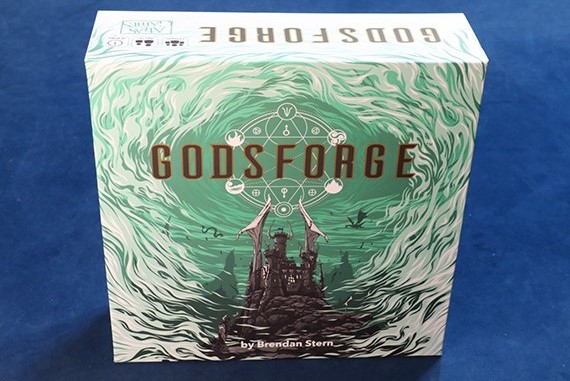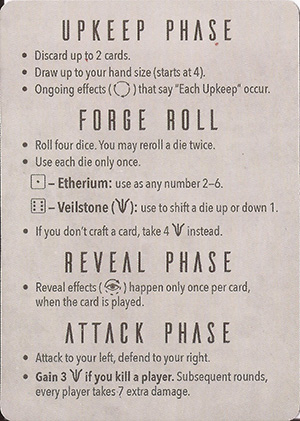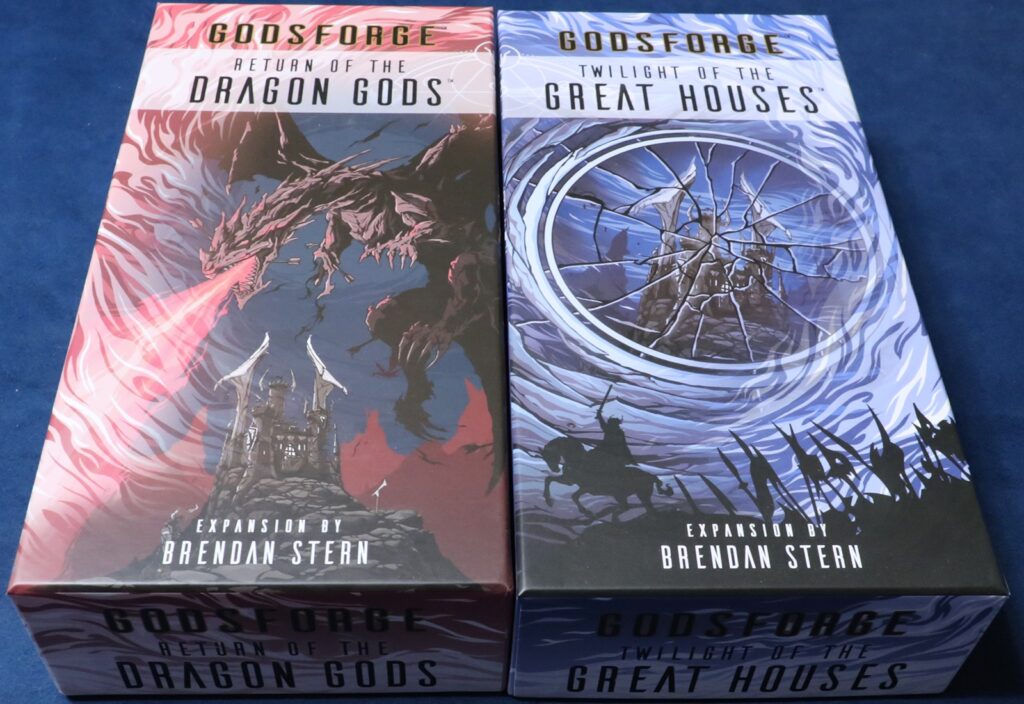
Etherium – the ender of famine, the bringer of peace and prosperity, used to be plentiful across the land. Now? Supplies have dried up and there is but a single site on the planet where this powerful source of magic can be found.
You are 1 of up to 4 wizards seeking to claim this source of power for yourself before this golden age draws to a close. To claim the coveted prize, you must weave Etherium with your magic to cast potent spells and summon mighty allies to take out the competition before they do the same to you.
Sometimes, you see a new board game and know it is a perfect addition to your board game cabinet. While the premise of Godsforge is admittedly pretty simple, I was sucked into its gameplay during Gen Con in 2021 and picked up a copy immediately after claiming co-victory in a demo game.
It didn’t take many playthroughs to convince the other Meeples of its merit either. Once you get a game or two in to grasp the rules, Godsforge becomes a great go-to when you want a quick, high energy board game that delivers exciting moments while still offering some strategic depth.
How to Play Godsforge
Once you’ve got the board on the table, place the gold Veilstones in the middle, shuffle the deck, deal 4 cards to each player (players may look at these), and give each player a matching set of 4 dice. Place the remainder of the deck on the middle of the board, and set a scoring marker for each player’s life total on the edge of the board. All players start with:
- 30 life for a 2 player game
- 25 life for a 3 player game
- 20 life for a 4-6 player game

Now that you’ve finished setup, you’re ready to begin the game. Everyone takes their turn at the same time in Godsforge, and turns are broken into 4 phases.
Upkeep
Everyone may choose to discard up to 2 cards from their hand, then draw back up to their maximum hand size (4 unless you have an ability that changes this limit). If there are any recurring effects that begin with the phrase “Each Upkeep”, resolve those at this time.
Forge Roll
Everyone rolls their 4 dice, then attempts to use what they’ve rolled to “craft” the prerequisites for 1 card in their hand. Each die may be used only once for this, but you can add dice together, spend a Veilstone to raise or lower the result of a die by 1 as many times as they like, or reroll one of your dice up to twice (the chosen die need not be the same for both rolls).
A few things to keep in mind as well:
- Ones are wild: A 1 on a die can be used as any number ranging from 2-6 instead. Yes, this will let you get a Veilstone if you so choose.
- Unused Sixes turn into Veilstones: If you have one or more extra 6s not used to craft a card, each may be redeemed for a Veilstone. This can also be done during the Forge Roll if you need a Veilstone to craft a card.
- You can only craft 1 card a turn: Unless a card you have or are about to play says otherwise. Once you’ve got the components for your crafted card, place it face down in front of you.
If you aren’t able to craft a card during your Forge Roll, you instead take 4 Veilstones, but do not collect any additional Veilstones from sixes in your dice pool.
Reveal
Everyone reveals their crafted cards at the same time, pays their costs (ignore unused Forge Roll dice), and resolves any Reveal effects (denoted by a picture of an eye) simultaneously. Reveal effects only trigger once per card.
Players then collect any Veilstones they didn’t redeem from sixes in their Forge Roll, and move to the Attack phase.
Attack
As the game progresses, you will usually play cards that have a red attack value or a blue defense value in the lower left corner. Add all the red numbers together, then all the blue numbers. Use the red total to attack the player to your left, and the blue total to prevent damage from the player on your right.
All other players do the same, then adjust their life totals accordingly. If cards have Attack Phase abilities (denoted by a pink border around them), these resolve simultaneously. If a player is reduced to 0 or less health at this point, they die and are eliminated from the game, and their killer receives 3 Veilstones.
During every subsequent Attack Phase after at least 1 player has been eliminated, all remaining players receive an additional 7 damage.
For additional questions about the rules, you can also consult the official Godsforge rulebook.
Godsforge Game Review

Overall, Godsforge does a lot very well. My favorite aspect of the game is that everyone takes their turns at the same time, making it extremely easy to stay engaged for the entire game. There might be moments during the Forge Roll where someone needs extra time to think, but beyond that, it always feels like there’s something happening you have a vested interest in.
Turns also flow very smoothly from beginning to end. There aren’t a lot of overly complicated mechanics to keep track of, and since you’re always attacking in the same direction and defending from the opposite direction, assessing your position at all stages of the game is incredibly straightforward.
There also doesn’t tend to be a lot of waiting for the next game if you get knocked out early – adding 7 damage to all remaining players after the first is knocked out prohibits the use of many tactics to stall for time, ensuring the remaining players will have to quickly resolve their conflict during most games.
In fact, it’s rare that a game lasts more than 30 minutes once everyone’s got the rules down.
Those who are more critical of Godsforge’s gameplay point to the fact that luck plays too large a role in the game, and I can see their point of view here. Card draw and dice rolls are both crucial in determining your available plays, and if one or both go badly for a couple turns, it’s easy to fall behind.
That said, Godsforge does a great job of giving players tools to make their own luck. Ones being wild during your dice rolls, Veilstones allowing you to manipulate your dice, Creations having abilities that improve your card selection and dice options, the ability to discard up to 2 cards for replacements every upkeep, and the option to take 4 Veilstones if you can’t play a card provide a lot of safety valves that are designed to keep you in the game.
Don’t just take our word for it though – check out some games we streamed and decide for yourself.
As you might have guessed from the video above, strategy in Godsforge tends to vary from game to game. In some games, you’re able to build up an unstoppable array of offensive Creations, becoming a juggernaut with damage that can’t be prevented and the occasional potent spell that lashes out at multiple opponents.
In other games, you may spend earlier turns building up defense and support cards to ensure you survive to play potent cards with high costs during later turns of the game. Flexibility and being able to accurately read both the game state and other opponents at the table can help you determine the best way to use your resources each turn.
There are a few good rules of thumb I’ve noticed from game to game, however, so I’ll share those discoveries for your reference:
- Support cards become less valuable as a game progresses. While extra cards and dice are incredibly useful early on, as offense starts to ramp up around the table, you’ll need to put more and more of your effort into cards that bolster your own offense and defense as turns pass.
- Don’t wait to destroy powerful Creations. While it is tempting to hold back a card that destroys one of your opponent’s cards until a huge threat comes down, it’s usually better to address a card of middling power if it is propelling someone ahead rather than waiting for a high power Creation to hit the table, especially in later stages of the game.
- Don’t neglect your Defense. While cards that deal damage are important for putting pressure on an opponent, a few points of damage here or there can add up very quickly – preventing as much early damage as you can will help you survive to see the later stages of a game.
- Save spells for finishing opponents off or avoiding your own death. Creations persist from turn to turn, so building up as many as you can is extremely beneficial. While spells offer more offense and defense than Creations, they typically last for one turn and then are gone.
Godsforge Kickstarter – 2nd Edition
In November of 2022, Atlas Games ran a Kickstarter for Godsforge that included a 2nd edition of the base game and expansions. The 2nd edition plays exactly the same way as the 1st edition run, but changes the aesthetic of the game components and revises the rules with clarity and environmentally friendly practices in mind.
Since neither of these changes has a real impact on the gameplay experience, I wouldn’t worry about unloading a 1st edition copy of this board game if you already have it – just refence the 2nd edition rules when they come out instead of 1st edition’s, as the extra clarifications should help with questions and interactions that are difficult to unravel in 1st edition.
Godsforge Expansions
Return of the Dragon Gods and Twilight of the Great Houses became available for order in July of 2023, and I’m stoked to see how these impact the gameplay of the base Godsforge game. Each can be played with the core game individually or with the other expansion included, offering multiple new directions for the Godsforge experience.

Return of the Dragon Gods naturally focuses on dragon-themed spells and Creations, but also adds the ability to upgrade your cards and provide synergy benefits for Creations of different types within its new mechanics, finally providing a reason for players to care about this aspect of the game.
Twilight of the Great Houses boasts new spells and Creations too, but its main new attraction is the inclusion of Great House cards, each providing a unique ability that can encourage specific playstyles during a game.
This expansion also introduces the “Lose Life” and “Cannot Play Creations” mechanics. Life loss cannot be prevented with damage prevention cards, and if you find yourself with a card preventing you from playing Creations, the only way you can play one in front of you is through the use of another spell or card ability that permits you to do so.
Both expansions also allow you to add an additional player to the game, expanding your maximum player count from 4 to 6. This is a great design move overall as most interactions during a game are with players on your immediate left and right, so you can get more people involved without necessarily bogging down gameplay.
My favorite update with these expansions is the advanced setup rule, which allows players to select 4 cards from a pool of 10 in their opening hand, and if you’re playing with the Twilight of the Great Houses expansion, you get to do this before selecting your house!
This solves the single biggest pain point we’ve found with our games, as certain hands with complicated dice requirements can feel unplayable in the early turns. Given how difficult it is to come back from behind in Godsforge, our playgroup is delighted that this has been addressed.
A solo play variant has also been added so you can jam some games between game nights, which is also pretty cool. Solo board games are definitely an uncommon breed, so it’s nice to see this style of play getting some love with the release of the expansions as well.
To learn more about these expansions, check out our 2nd edition Godsforge review!
Is Godsforge a Good Game – Final Thoughts
If you like short, high energy board games that are easy to learn but fun to come back to again and again, Godsforge will make a fine addition to your board game collection. We’ve worked it into our rotation with other short games like Point Salad, Sushi Go Party, Blokus, and Trash Pandas, and I expect it will stay there a long time.
I’d also say Godsforge is also a great pickup for families who play board games with their kids. The mechanics are easy to understand, there’s more strategy than classics like Sorry! and Battleship have to offer, and games are short enough and involved enough to hold the attention of most children all the way through.
For those who are specifically looking for a longer game with the opportunity for a lot of strategic depth, such as Lords of Waterdeep, Bunny Kingdom, or Axis and Allies, Godsforge might come up short. I’d still recommend giving it a look, but you don’t exactly need to be a cerebral titan to figure out the nuts and bolts of its gameplay.
Other Board Game Articles You May Love
- Sushi Go Strategy
- Why Are Board Games So Popular?
- Best Smash Up Expansions List
- Carcassonne vs Kingdomino
- Machi Koro Strategy
Braden is a founder of Assorted Meeples and has been a gamer & writer with a vivid imagination all his life. Don’t believe us? Check out his excitement when meeting Goosebumps author R.L. Stine as a kid! An avid Magic: The Gathering spellslinger for over 15 years, you can always convince him to shuffle up for a game (or three!) of Commander.
